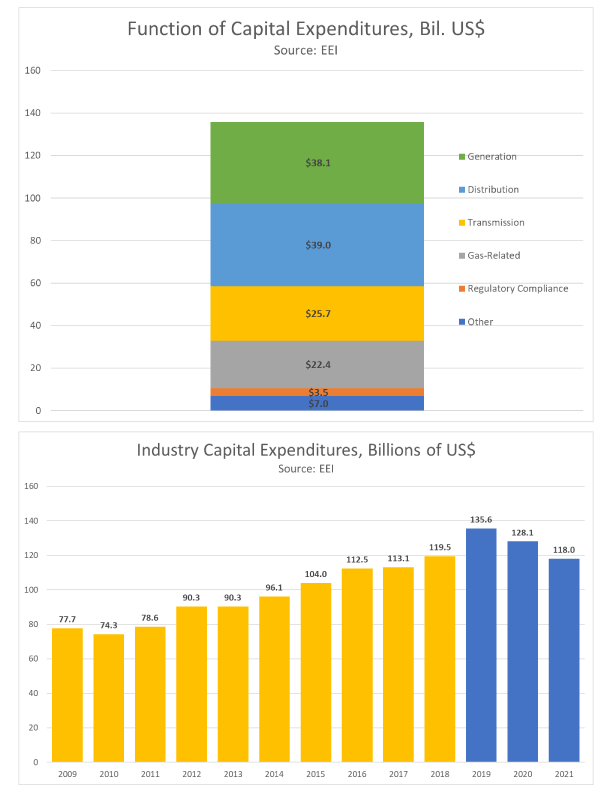by Fred Ashton, Economist, NEMA
January/February 2020
Despite modest growth in U.S. electricity consumption over the last decade, 2019 saw record capital expenditures by utilities. Wildfires, hurricanes, and cyber attacks forced utilities to accelerate spending to replace aging infrastructure with more digitized equipment that could help prevent future failures from man made and natural disasters, according to an analysis conducted by Deloitte.1
The Edison Electric Institute2 predicted that capital expenditures by U.S. investor-owned electric utilities would reach $135.6 billion by the end of 2019, an increase of more than 13 percent from the previous year. Of the $135.6 billion, $38.1 billion was expected to go toward generation, $39.0 billion for distribution, and $25.7 billion for transmission projects.

Following the devastation caused by Hurricanes Maria and Irma, Puerto Rico found itself with 80 percent of its transmission and distribution systems destroyed. Since then, the island has focused much of its recovery effort on investing in microgrids. According to an article by Wood Mackenzie,3 the microgrid market in Puerto Rico is forecast to reach 228 megawatts by the end of 2024, with cumulative market investment exceeding $419 million.
Many utilities are embracing decentralization, moving away from generating and transmitting electricity using a centralized system. An article published by Microgrid Knowledge4 cited the results of an Accenture survey revealing that 40 percent of the utilities they surveyed said that “they see microgrids along with energy storage and data as key opportunities through 2025.” Additionally, Lola Infante, senior director at EEI, noted at the Microgrid 2019 Conference that “half of all microgrids have some utility involvement compared to 10 percent a few years ago.” Infante also commented that utilities are investing a combined $100 billion to upgrade their networks.
Microgrids currently provide less than 0.2 percent of U.S. electricity, so the industry is undoubtedly in its infancy. However, capacity is expected to more than double in the next three years, according to the Center for Climate and Energy Solutions.5 Utilities are likely to continue developing and incorporating this technology as part of their electricity distribution plans to mitigate incidences like those experienced in the aftermath of Hurricanes Maria and Irma. ei
- 2020 Power and Utilities Industry Outlook, Deloitte, 2019, bit.ly/2020PowerOutlook.
- Industry Capital Expenditures, Edison Electric Institute (eei), October 2019, http://bit.ly/eeianalysis.
- “Puerto Rico Microgrid Market to More than Double by End of 2024,” Wood Mackenzie, June 3, 2019, bit.ly/PRmicrogrid.
- Ken Silverstein, “Utilities are Giving Microgrids the Jolt They Need to Get Up and Going,” Microgrid Knowledge, May 21, 2019, microgridknowledge.com/ utility-microgrid-2019.
- Microgrids At-a-Glance, Center for Climate and Energy Solutions, www.c2es.org/content/microgrids/.